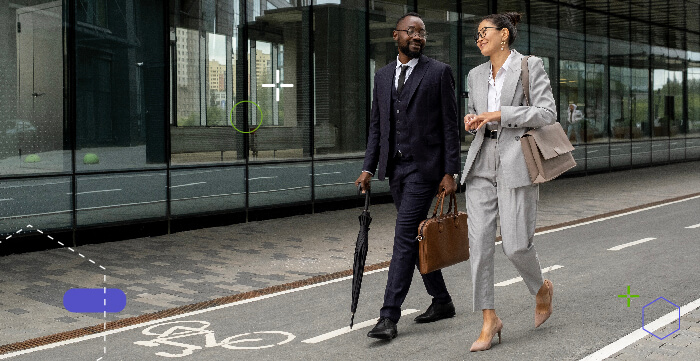Government offices can improve the customer experience through updating processes and streamlining citizen flow in their facilities.
Customer experience is no longer a buzzword, but rather the cornerstone of any company that wants to succeed in the modern era. The reason is simple: an unhappy customer is a lost customer. When customers are dissatisfied with a product or service, they might simply switch lanes to the competition, leaving a brand with less revenue in their quarterly spreadsheets.
What happens when the "company" is the government, and the "customers are citizens? With no competition to turn to, people have no choice but to put up with bureaucracy, a word that has become a synonym for long queues, stand-by tones, and frustration.
In the U.S, citizen satisfaction with federal government services has been plummeting for four years, reaching an all-time low score of 63.4% in 2021, according to the latest annual report of the American Customer Satisfaction Index (ACSI). In addition, COVID-19 exacerbated this situation, as the pandemic forced institutions to accelerate the embrace of digital transformation. This exposed some bottlenecks along the way and has left Americans more dissatisfied than ever regarding government offices.
Is there a way to look at bureaucracy through a positive lens? Fortunately, yes. Here’s how.
1. Streamline Data
When citizens wait too long, they get annoyed and even agitated. This also impacts the staff, as stress builds up on their end while trying to solve issues as quickly as possible.
A queue management system (QMS) is a solution that offers data for decision-makers to improve office systems and flows as necessary while improving employee satisfaction by decreasing stress. From automated workflows before an appointment to improving a person’s experience during the appointment, a QMS means a win-win for both the customers and the organization.
In terms of government offices, one of the most common complaints among US citizens is the lack of efficiency and accessibility limitations. On any given day, there could be a citizen with special requirements (i.e., accessibility needs like speaking a foreign language or hearing impairment), that limit their ability to complete their task without assistance.
A virtual queue management system can match citizens with the right employee, routing the person to the location and/or staff member who can provide the best service fastest, thus improving efficiency and overall customer satisfaction.
2. Manage Wait Times
Wait times are another usual complaint about government-run facilities. Appreciation of time (deepened by COVID-19) has become one of the most highly valued issues among people. Major time issues arise when it comes to government-issued paperwork, though it is necessary to complete several appointment processes. The pandemic also delayed numerous day-to-day procedures, further complicating the picture.
As previously mentioned, office staff know that customers start to feel annoyed, angry, or even aggressive when they experience long wait times. However, an Appointment Booking tool optimizes the customer experience with smart appointment management solutions, providing a hassle-free process for citizens.
An automated appointment tool also reduces no-show rates, as customer alerts remind them they have an appointment and warn them about any delays, helping them to manage wait time expectations.
On the business intelligence side, booking software also gives an organization insights into identifying appointment scheduling patterns, allowing teams to be one step ahead and improve the customer experience by preventing long delays.
Automation empowers citizens to take control of their own time, allowing staff more time to focus on higher-priority tasks, ultimately reducing operating costs.

3. Fix the Queuing Problem
The length of a line and the delay duration are a large part of customer dissatisfaction and the overall problem. How citizens experience that duration, however, is at the core of the experience, as they perceive that time goes by faster while they are occupied with something significant.
So, what if your citizens could join an online queue and “wait” in line while making the most of their time? That is exactly what a Virtual Queuing solution does.
Thanks to a Virtual Queuing System, long lines outside a government office are now becoming a thing of the past. People can join an online queue through their mobile device, receive real-time updates on their nearby branches’ waiting times and get an alert when it is their turn to be served, avoiding queues and crowded lobbies (especially during busy periods).
4. Seamlessly Collect and Unify Customer Data
As a citizen in a government office, have you ever…
- provided the same personal information to an employee more than once?
- found paper forms tiresome and confusing?
- not had the proper tools when required to fill out paper forms?
Customer dissatisfaction in government agencies stems from repeated processes, confusing and lengthy forms, and outdated data collection processes. They prefer an option that requires a quick, single-time entry.
Collect customer feedback and data effortlessly with an Online Forms solution. Save time (and paper) using intuitive, branded online forms that are simple to design and easy for citizens to complete, automatically saving their responses in the process record or as part of each record.
Other key features for government purposes include multilingual support, e-signature collection & authentication, and pre-service data collection.
5. Enable Remote Appointments
COVID-19 has profoundly changed how we live, work and interact with others. Now, in the aftermath of such a disruptive phenomenon, the possibility of choosing to attend events in person or remotely is here to stay. And people appreciate flexibility now more than ever.
A virtual appointment solution allows customers to have their consultation or appointment remotely through video, either via mobile or web app, adapting the service to them and not the other way around. The session is end-to-end encrypted and takes place in a virtual waiting room, where customers can be notified shortly before their appointment.
Concerning government customer experience, this could be beyond beneficial, as not all citizens can commute to their nearest office for any number of reasons, including living abroad.
By personalizing the digital interaction between customers and staff, an organization can increase overall staff productivity, reduce cost-per-interaction and shift customers to a more efficient engagement channel.

6. Learn from your customers
In this case, citizens.
Organizations can’t improve what can’t be measured. To provide outstanding customer service in the government industry, you need to ensure that every employee in your company knows where most problems are (and why they arise in the first place). To achieve this, an organization needs to:
- Track peak traffic & wait times
- Collect and analyze customer feedback
- Create and access customizable dashboards to visualize the impact and purpose of data
Insights allow a government office to make operations adjustments in real-time and strategically plan according to longer-term data, both responding quickly and setting the course for the long run.
7. Embrace an omnichannel strategy
The word “omnichannel” has been heard a lot over the last few years, yet not all companies have managed to deliver a true omnichannel experience regarding customer service.
How so?
Because the key to an outstanding customer experience does not require a presence on multiple channels but rather integrates all of a brand's channels to deliver a unified, high-quality, and seamless customer experience.
So, when it comes to government-related procedures, it is crucial to put citizens at the center of every journey and act accordingly, leveraging digital tools that can contribute to making everything more efficient.
Moving Forward
If you are a U.S. citizen, you know tedious it is to spend hours at government offices. You know the pain points from a customer perspective and how they need to be tackled to improve the citizen experience.
In conclusion, managing customer experience in U.S. government offices has never been easy, let alone after a pandemic that has brought a worldwide crisis that requires adjustments across all sectors. Nevertheless, any crisis also brings along opportunities for transformation, reinvention, and taking a qualitative leap in the sectors that need it the most.
To learn more about how to improve the citizen experience in government offices, contact us or schedule a demo today.




